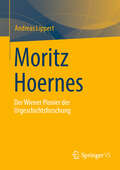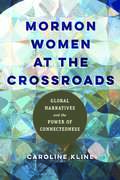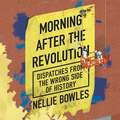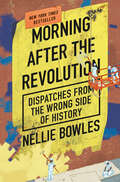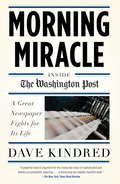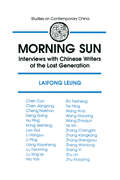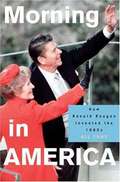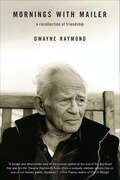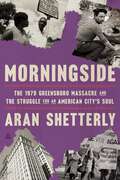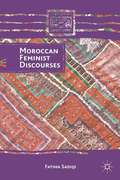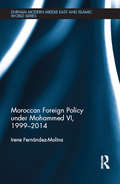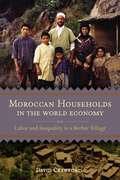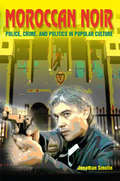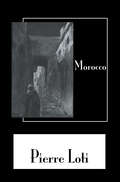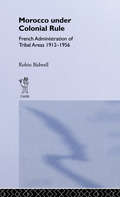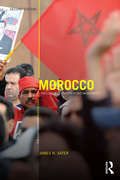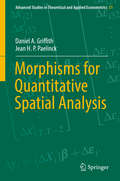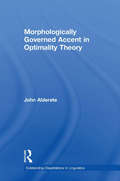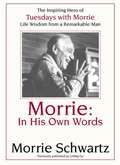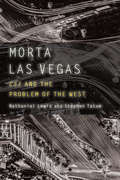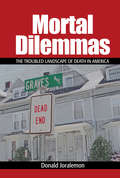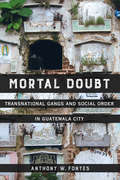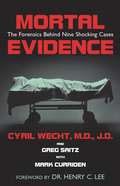- Table View
- List View
Moritz Hoernes: Pionier der Urgeschichtsforschung
by Andreas LippertDer Band ist eine Biografie des ersten Lehrkanzelinhabers für Prähistorische Archäologie im deutschen Sprachraum. Nach einer längeren Zeit von Forschungen in Bosnien und der Herzegowina fand Hoernes eine Anstellung in der Prähistorischen Sammlung des Naturhistorischen Hofmuseums in Wien. Hier erst entschied er sich für urgeschichtliche Forschungen. Er habilitierte sich für das Fach 1892 und wurde bereits 1899 zum außerordentlichen Univ.-Professor an der Universität Wien ernannt. 1911 erfolgte dann seine Berufung als ordentlicher Univ.-Professor an dieser Universität. Hoernes verfasste einige bedeutende Übersichtswerke zur Urgeschichte in Europa, die noch heute Geltung haben, und zahlreiche Fachbeiträge.
Mormon Women at the Crossroads: Global Narratives and the Power of Connectedness
by Caroline KlineThe Church of Jesus Christ of Latter-day Saints continues to contend with longstanding tensions surrounding gender and race. Yet women of color in the United States and across the Global South adopt and adapt the faith to their contexts, many sharing the high level of satisfaction expressed by Latter-day Saints in general. Caroline Kline explores the ways Latter-day Saint women of color in Mexico, Botswana, and the United States navigate gender norms, but also how their moral priorities and actions challenge Western feminist assumptions. Kline analyzes these traditional religious women through non-oppressive connectedness, a worldview that blends elements of female empowerment and liberation with a broader focus on fostering positive and productive relationships in different realms. Even as members of a patriarchal institution, the women feel a sense of liberation that empowers them to work against oppression and against alienation from both God and other human beings. Vivid and groundbreaking, Mormon Women at the Crossroads merges interviews with theory to offer a rare discussion of Latter-day Saint women from a global perspective.
Morning After the Revolution: Dispatches From the Wrong Side of History
by Nellie BowlesFrom former New York Times reporter Nellie Bowles comes an irreverent romp through the sacred spaces of the new left.As a Hillary voter, a New York Times reporter, and a frequent attendee at her local gay bars, Nellie Bowles fit right in with her San Francisco neighbors and friends - until she started questioning whether the progressive movement she knew and loved was actually helping people.When her colleagues suggested that asking these questions meant she was 'on the wrong side of history,' Bowles did what any reporter worth her salt would do: she started investigating for herself. The answers she found were stranger - and funnier - than she'd expected.In Morning After the Revolution, Bowles gives readers a front-row seat to the absurd drama of a political movement gone mad. With irreverent accounts of attending a multi-day course on 'The Toxic Trends of Whiteness,' following the social justice activists who run 'Abolitionist Entertainment, LLC,' and trying to please the New York Times's 'disinformation czar,' she deftly exposes the more comic excesses of a movement that went from a sideshow to the very centre of Western life.Deliciously funny and painfully insightful, Morning After the Revolution is a moment of collective psychosis preserved in amber.
Morning After the Revolution: Dispatches from the Wrong Side of History
by Nellie BowlesNEW YORK TIMES BESTSELLERFrom former New York Times reporter Nellie Bowles, a look at how some of the most educated people in America lost their minds—and how she almost did, too.As a Hillary voter, a New York Times reporter, and frequent attendee at her local gay bars, Nellie Bowles fit right in with her San Francisco neighbors and friends—until she started questioning whether the progressive movement she knew and loved was actually helping people. When her colleagues suggested that asking such questions meant she was &“on the wrong side of history,&” Bowles did what any reporter worth her salt would do: she started investigating for herself. The answers she found were stranger—and funnier—than she expected.In Morning After the Revolution, Bowles gives readers a front-row seat to the absurd drama of a political movement gone mad. With irreverent accounts of attending a multiday course on &“The Toxic Trends of Whiteness,&” following the social justice activists who run &“Abolitionist Entertainment LLC,&” and trying to please the New York Times&’s &“disinformation czar,&” she deftly exposes the more comic excesses of a movement that went from a sideshow to the very center of American life.Deliciously funny and painfully insightful, Morning After the Revolution is a moment of collective psychosis preserved in amber. This is an unmissable debut by one of America&’s sharpest journalists.
Morning Miracle: A Great Newspaper Fights for Its Life
by Dave KindredWhat The Kingdom and the Power did for the New York Times, Morning Miracle will do for the Washington Post. A reporter for more than forty years, Dave Kindred takes you inside the heart of the legendary newspaper and offers a unique opportunity to see what it really takes to produce world-class journalism every day. Granted unprecedented access to every nook and cranny of the paper, including candid exchanges with its most celebrated journalists, such as Bob Woodward, Sally Quinn, David Broder, and former executive editor Ben Bradlee (who gave the book its title), Kindred provides a no-holds-barred look at the twenty-first-century newsroom. As it becomes more difficult to maintain journalistic integrity, stay relevant in the age of blogs, and meet Wall Street’s demands for profits, the newspaper—more than any other medium—also shoulders the tremendous responsibility of acting as a watchdog for democracy. Perhaps no one sums up the overwhelming challenges that face the Post and its power to endure better than the author himself: “It is still a miracle that you can put 700 overcaffeinated misfits in a newsroom, on deadline, adrenaline running, secrets to spill, and before midnight a messenger delivers a smoking-hot city edition to Don Graham’s manse in Georgetown.”
Morning Sun: Interviews with Chinese Writers of the Lost Generation
by Laifong Leung Jan WallsThis is a collection of interviews with 26 writers of China's "zhiqing" generation, relatively young artists who participated in the Cultural Revolution as teen-age Red Guards, suffered through the subsequent rustication of intellectual youth, and eventually returned to relatively normal lives, but always with a tragic hiatus haunting their formative years. While one goal of Professor Leung is to introduce to the West an important group of writers little-known outside China, she also aims to succeed, through the interviews, in providing a special perspective on the devastating political history of China since the 1970s years through the eyes of its keenest observers and in offering a perspective on the social, political and cultural milieu of the period.
Morning in America: How Ronald Reagan Invented the 1980s
by Gil TroyA reassessment of Ronald Reagan's legacy takes us through the 1980s in ten year-by-year chapters, combining stories of the Reagan presidency and stories of the decade's cultural icons and watershed.
Morning, Noon, and Night: Finding the Meaning of Life's Stages Through Books
by Arnold WeinsteinFrom Homer and Shakespeare to Toni Morrison and Jonathan Safran Foer, major works of literature have a great deal to teach us about two of life's most significant stages--growing up and growing old. Distinguised scholar Arnold Weinstein's provocative and engaging new book, Morning, Noon, and Night, explores classic writing's insights into coming-of-age and surrendering to time, and considers the impact of these revelations upon our lives. With wisdom, humor, and moving personal observations, Weinstein leads us to look deep inside ourselves and these great books, to see how we can use art as both mirror and guide. He offers incisive readings of seminal novels about childhood-Huck Finn's empathy for the runaway slave Jim illuminates a child's moral education; Catherine and Heathcliff's struggle with obsessive passion in Wuthering Heights is hauntingly familiar to many young lovers; Dickens's Pip, in Great Expectations, must grapple with a world that wishes him harm; and in Marjane Satrapi's autobiographical Persepolis, little Marjane faces a different kind of struggle--growing into adolescence as her country moves through the pain of the Iranian Revolution. In turn, great writers also ponder the lessons learned in life's twilight years: both King Lear and Willy Loman suffer as their patriarchal authority collapses and death creeps up; Brecht's Mother Courage displays the inspiring indomitability of an aging woman who has "borne every possible blow... but is still standing, still moving." And older love can sometimes be funny (Rip Van Winkle conveniently sleeps right through his marriage) and sometimes tragic (as J. M. Coetzee's David Lurie learns the hard way, in Disgrace). Tapping into the hearts and minds of memorable characters, from Sophocles' Oedipus to Artie in Art Spiegelman's Maus, Morning, Noon, and Night makes an eloquent and powerful case for the role of great literature as a knowing window into our lives and times. Its intelligence, passion, and genuine appreciation for the written word remind us just how crucial books are to the business of being human.
Mornings at the Stanton Street Shul: A Summer on the Lower East Side
by Jonathan BoyarinThis story of one of the last remaining synagogues in the historic neighborhood and its congregation is &“as absorbing as a good cinema verité documentary&” (Booklist). On New York&’s Lower East Side, a narrow building, wedged into a lot designed for an old-law tenement, is full of clamorous voices—the generations of the dead, who somehow contrive to make their presence known, and the newer generation, keeping the building and its memories alive and making themselves Jews in the process. In this book, Jonathan Boyarin, at once a member of the congregation and a bemused anthropologist, follows this congregation of &“year-round Jews&” through the course of a summer during which its future must once again be decided. Famous as the jumping off point for millions of Jewish and other immigrants to America, the neighborhood has recently become the hip playground of twentysomething immigrants to the city from elsewhere in America and from abroad. Few imagine that Jewish life there has stubbornly continued through this history of decline and regeneration. Yet, inside with Boyarin, we see the congregation&’s life as a combination of quiet heroism, ironic humor, lively disputes, and—above all—the ongoing search for ways to connect with Jewish ancestors while remaining true to oneself in the present. Mornings at the Stanton Street Shul is both a portrait of a historic neighborhood facing the challenges of gentrification, and a poignant, humorous chronicle of vibrant, imperfect, down-to-earth individuals coming together to make a community.
Mornings with Mailer: A Recollection of Friendship
by Dwayne Raymond“Mornings with Mailer is a tender and affectionate view of the protean author at the end of the Big Novel that was his life. Dwayne Raymond’s book offers a uniquely intimate perspective on one of our literary giants. Applause.” — Tom Piazza, author of City of Refuge“In this moving memoir, Dwayne Raymond provides an intimate look at the daily routine of a great writer in the last years of his life.” — Doris Kearns Goodwin, Pulitzer Prize-winning author of Team of Rivals Mornings with Mailer is the revealing memoir by Dwayne Raymond, the man who worked as Norman Mailer’s personal assistant during the last five years of the iconic author’s life. Recasting the legendary writer of such classics as The Naked and the Dead and The Executioner’s Song in a new light, Mornings with Mailer describes the powerful bond that formed between him and Raymond from April 2003 until Mailer’s death in November 2007.
Morningside: The 1979 Greensboro Massacre and the Struggle for an American City's Soul
by Aran ShetterlyAn unflinching look at the all but forgotten though no less shocking 1979 racial tragedy that divided Greensboro, N.C., and the nation, and the grassroots activists who, in their tireless fight for justice, refused to give up on America’s promised ideals.On November 3, 1979, as activist Nelson Johnson assembled people for a march adjacent to Morningside Homes in Greensboro, North Carolina, gunshots rang out. A caravan of Klansmen and Neo-Nazis sped from the scene, leaving behind five dead. Known as the “Greensboro Massacre,” the event and its aftermath encapsulate the racial conflict, economic anxiety, clash of ideologies, and toxic mix of corruption and conspiracy that roiled American democracy then—and threaten it today.In 88 seconds, one Southern city shattered over irreconcilable visions of America’s past and future. When the shooters are acquitted in the courts, Reverend Johnson, his wife Joyce, and their allies, at odds with the police and the Greensboro establishment, sought alternative forms of justice. As the Johnsons rebuilt their lives after 1979, they found inspiration in Nelson Mandela’s post-apartheid Truth and Reconciliation Commission and Martin Luther King Jr’s concept of Beloved Community and insist that only by facing history’s hardest truths can healing come to the city they refuse to give up on.This intimate, deeply researched, and heart-stopping account draws upon survivor interviews, court documents, and the files from one of the largest investigations in FBI history. The persistent mysteries of the case touch deep cultural insecurities and contradictions about race and class. A quintessentially American story, Morningside explores the courage required to make change and the evolving pursuit of a more inclusive and equal future.
Moroccan Feminist Discourses
by Fatima SadiqiThis book is both scholarly and personal. It is scholarly because it addresses and assesses the current Moroccan feminist discourses, a topic the author has been involved with for almost three decades, and it is personal because it brings along her Berber identity and seeks to reposition it vis-a-vis these feminist discourses. Revisiting the Moroccan feminist discourses in the aftermath of the uprisings in the region which, among other things, brought about the spectacular change in the political status of Berber from an indigenous centuries-long marginalized language to an 'official language' of Morocco came with serious challenges to the feminist discourses by highlighting the stark absence of Berber, a women-related language, in these discourses. The two recognized types of feminist discourse, the secular and Islamic ones, are not only divergent but suffer from a shortage in scope and discard the rich heritage, knowledge, and art that Berber women bring along to the Moroccan feminist discourses. "
Moroccan Foreign Policy under Mohammed VI, 1999-2014 (Durham Modern Middle East and Islamic World Series)
by Irene Fernandez-MolinaThis book presents a comprehensive survey of Moroccan foreign policy since 1999. It considers the objectives, actors and decision-making processes involved, and outlines Morocco's foreign policy activity in key areas such as the international management of the Western Sahara conflict and relations with the other states of North Africa, relations with the European Union, especially France and Spain, and relations with the United States and the Middle East. <P><P>The book links the behaviour and discourses analysed to differing conceptions of Morocco's national role on the international scene - champion of national territorial integrity, model student of the EU, and good ally of the United States - and shows how these competing approaches to the country's foreign policy enjoy different degrees of domestic consensus, and result in different degrees of legitimation for the regime.
Moroccan Households in the World Economy: Labor and Inequality in a Berber Village
by David CrawfordIn the High Atlas Mountains of Morocco, far from the hustle and noise of urban centers, lies a village made of mud and rock, barely discernible from the surrounding landscape. Yet a closer look reveals a carefully planned community of homes nestled above the trees, where rock slides are least frequent, and steep terraces of barley fields situated just above spring flood level. The Berber-speaking Muslims who live and farm on these precipitous mountainsides work together at the arduous task of irrigating the fields during the dry season, continuing a long tradition of managing land, labor, and other essential resources collectively. In Moroccan Households in the World Economy, David Crawford provides a detailed study of the rhythms of highland Berber life, from the daily routines of making a living in such a demanding environment to the relationships between individuals, the community, and the national economy. Demonstrating a remarkably complete understanding of every household and person in the village, Crawford traces the intricacies of cooperation between households over time. Employing a calculus known as "arranging the bones," villagers attempt to balance inequality over the long term by accounting for fluctuations in the needs and capacities of each person, household, and family at different stages in its history. Tradition dictates that children "owe" labor to their parents and grandparents as long as they live, and fathers decide when and where the children in their household work. Some may be asked to work for distant religious lodges or urban relatives they haven't met because of a promise made by long-dead ancestors. Others must migrate to cities to work as wage laborers and send their earnings home to support their rural households. While men and women leave their community to work, Morocco and the wider world come to the village in the form of administrators, development agents, and those representing commercial interests, all with their own agendas and senses of time. Integrating a classic village-level study that nevertheless engages with the realities of contemporary migration, Crawford succinctly summarizes common perceptions and misperceptions about the community while providing a salient critique of the global expansion of capital. In this beautifully observed ethnography, Crawford challenges assumptions about how Western economic processes transfer to other contexts and pulls the reader into an exotic world of smoke-filled kitchens, dirt-floored rooms, and communal rooftop meals -- a world every bit as fascinating as it is instructive.
Moroccan Noir
by Jonathan SmolinFacing rising demands for human rights and the rule of law, the Moroccan state fostered new mass media and cultivated more positive images of the police, once the symbol of state repression, reinventing the relationship between citizen and state for a new era. Jonathan Smolin examines popular culture and mass media to understand the changing nature of authoritarianism in Morocco over the past two decades. Using neglected Arabic sources including crime tabloids, television movies, true-crime journalism, and police advertising, Smolin sheds new light on politics and popular culture in the Middle East and North Africa.
Morocco
by Pierre LotiFirst Published in 2002. Pierre Loti was a member of a diplomatic mission to the Sultan of Morocco at Fez, and in this book he gives us an extraordinarily fascinating account of the journey. The departure of the caravan from Tangier, the encampments, the nightly arrival of the Mouna, the crossing of the Oued-M'Cazen in flood, the fantasies and 'powder-play' of the Arab horsemen, and the magnificent state entry into Fez, are described in a succession of vivid vignettes.
Morocco Under Colonial Rule: French Administration of Tribal Areas 1912-1956
by Robin BidwellThis evaluation of the work of a colonial administration uses an analysis of the policies employed in the fields of education, administration, justice and agriculture. It shows how a largely archaic and isolated country transformed itself and its relationship with the western world.
Morocco: Challenges to tradition and modernity (The Contemporary Middle East)
by James N. SaterThe first edition of Morocco was published one year before the mass protests of the Arab Spring rocked the Moroccan state. Post-Arab Spring, the country has a new constitution and government, but the state remains uncompromising on any true reform of the monarchy’s claims to power. This new edition provides an introductory overview of the history, contemporary politics, economy, and international relations in Morocco and offers an examination of the challenges to tradition and modernity in the post-colonial state. It has been revised and updated to include analysis of the country’s evolving politics in the years following the Arab Spring, and the consequences this has had for the country’s traditional monarchy. It pays particular attention to the new constitution, the policies of the new Islamist-led government, and it includes an analysis of Morocco’s foreign policy in the post-Arab Spring regional context. Drawing on key academic texts, the author provides a detailed analysis of Morocco, focusing on issues such as: • Morocco’s role within the region • Trade policies with Europe • Migration • Morocco’s Western Sahara policy • Ways of dealing with Political Islam • The extent to which European influence has affected Moroccan society Easily accessible to non-specialists, practitioners, and upper level undergraduate students, the book will be essential reading for those working in the fields of North African studies, International Relations and Middle East studies.
Morphisms for Quantitative Spatial Analysis (Advanced Studies In Theoretical And Applied Econometrics Ser. #51)
by Daniel A. Griffith Jean H. PaelinckThis book treats the notion of morphisms in spatial analysis, paralleling these concepts in spatial statistics (Part I) and spatial econometrics (Part II). The principal concept is morphism (e.g., isomorphisms, homomorphisms, and allomorphisms), which is defined as a structure preserving the functional linkage between mathematical properties or operations in spatial statistics and spatial econometrics, among other disciplines. The purpose of this book is to present selected conceptions in both domains that are structurally the same, even though their labelling and the notation for their elements may differ. As the approaches presented here are applied to empirical materials in geography and economics, the book will also be of interest to scholars of regional science, quantitative geography and the geospatial sciences. It is a follow-up to the book “Non-standard Spatial Statistics and Spatial Econometrics” by the same authors, which was published by Springer in 2011.
Morphologically Governed Accent in Optimality Theory (Outstanding Dissertations in Linguistics)
by John D. AldereteAlderete examines the influences of morphological factors on stress and pitch accent within Optimality Theory.
Morrie: In His Own Words
by Morrie SchwartzFrom the book: In these remarkable pages are the profound, life-affirming words of Morrie Schwartz (the hero of Tuesdays with Morrie) as he faced his own imminent death. In 1994, at the age of seventy-seven, Schwartz learned he had A L S, commonly known as Lou Gehrig's disease. Undaunted, the former professor embraced his illness, choosing to live passionately and calmly until the end. He also embarked on his greatest teaching adventure: sharing his evolving knowledge of living while dying. With warmth, wisdom, and humor, Morrie reveals how to...live fully in the moment...tap into the powers of the mind to transcend physical limitations...grieve for your losses...reach out to family and friends... develop an inner space for meditation and spiritual connection. It's never too late to become the kind of person you'd like to be. Morrie shows the way in his magnificent legacy of love, forgiveness, transcendence, and redemption, a guide to living fully to the end of your days.
Morta Las Vegas: CSI and the Problem of the West (Postwestern Horizons)
by Nathaniel Lewis Stephen TatumThrough all its transformations and reinventions over the past century, “Sin City” has consistently been regarded by artists and cultural critics as expressing in purest form, for better or worse, an aesthetic and social order spawned by neon signs and institutionalized indulgence. In other words, Las Vegas provides a codex with which to confront the problems of the West and to track the people, materials, ideas, and virtual images that constitute postregional space.Morta Las Vegas considers Las Vegas and the problem of regional identity in the American West through a case study of a single episode of the television crime drama CSI: Crime Scene Investigation. Delving deep into the interwoven events of the episode titled “4 × 4,” but resisting a linear, logical case-study approach, the authors draw connections between the city—a layered and complex world—and the violent, uncanny mysteries of a crime scene. Morta Las Vegas reveals nuanced issues characterizing the emergence of a postregional West, moving back and forth between a geographical and a procedural site and into a place both in between and beyond Western identity.
Mortal Dilemmas: The Troubled Landscape of Death in America
by Donald JoralemonAnthropologist Donald Joralemon asks whether America is really, as many scholars claim, a death-denying culture that prefers to quarantine the sick in hospitals and the elderly in nursing homes. His answer is a reasoned “no.” In his view, Americans are merely struggling to find cultural scripts for the exceptional conditions of dying that our social world and medical technologies have thrust upon us. The book: is written in the first-person for a broad audience by a senior anthropologist, making it an authoritative yet accessible textbook for courses on death and dying and American culture; includes contemporary debates about highly visible cases, the definition of death, the status of human remains, aging, and the medicalization of grief; demonstrates persuasively that arguments over death and dying are in fact arguments about what it means to be human in modern America.
Mortal Doubt: Transnational Gangs and Social Order in Guatemala City (Atelier: Ethnographic Inquiry in the Twenty-First Century #1)
by Anthony W. FontesThe fear of violent crime dominates Guatemala City. In the midst of unprecedented levels of postwar violence, Guatemalans struggle to fathom the myriad forces that have made life in this city so deeply insecure. Born out of histories of state terror, migration, and US deportation, maras (transnational gangs) have become the face of this new era of violence. They are brutal organizations engaged in extortion, contract killings, and the drug trade, and yet they have also become essential to the emergence of a certain kind of social order. Drawing on years of fieldwork inside prisons, police precincts, and gang-dominated neighborhoods, Anthony W. Fontes demonstrates how gang violence has become indissoluble from contemporary social imaginaries and how these gangs provide cover for a host of other criminal actors. Ethnographically rich and unflinchingly critical, Mortal Doubt illuminates the maras’ role in making and mooring collective terror in Guatemala City while tracing the ties that bind this violence to those residing in far safer environs.
Mortal Evidence: The Forensics Behind Nine Shocking Cases
by Cyril H. WechtA lifeless newborn baby is found discarded in a motel Dumpster. Authorities quickly arrest the infant's teenage parents, charging them with murder. Did Amy Grossberg and Brian Peterson, in fact, murder their own baby? Tammy Wynette died suddenly at a relatively young age, and yet no autopsy was performed? Was someone trying to hide the real cause of death? Did Sam Sheppard (later dubbed "The Fugitive" based on a television series) really kill his wife? And if not, who committed the murder?Things are not always as they appear, as world-renowned forensic pathologist Dr. Cyril Wecht shows in this riveting behind-the-scenes look at nine famous cases. In the nationally known baby case involving Amy Grossberg and Brian Peterson, Dr. Wecht reviews the evidence and comes to a startling conclusion. In fascinating detail, he demonstrates how the tools of forensic pathology often uncover murky, long-hidden secrets that crack seemingly unsolvable crimes. Writing in the first-person Dr. Wecht leads you into the heart of the investigation, focusing each chapter on a single engrossing drama. He reveals the most startling evidence that shows why JonBenet Ramsey's killer most likely came from within her home, why O.J. Simpson probably had an accomplice in the murder of Nicole Simpson and Ron Goldman, shocking revelations about Robert Berdella's grisly torture and sex-abuse crimes against young men, and many intriguing facts about other infamous cases.If you find the fictional plots of such dramas as C.S.I. exciting, you will be amazed by the true stories told by Dr. Wecht, with the help of two top-flight veteran reporters, Greg Saitz and Mark Curriden, in this amazing real-life thriller. As this intriguing page-turner proves, the science of forensic pathology has changed the face of detective work forever.
